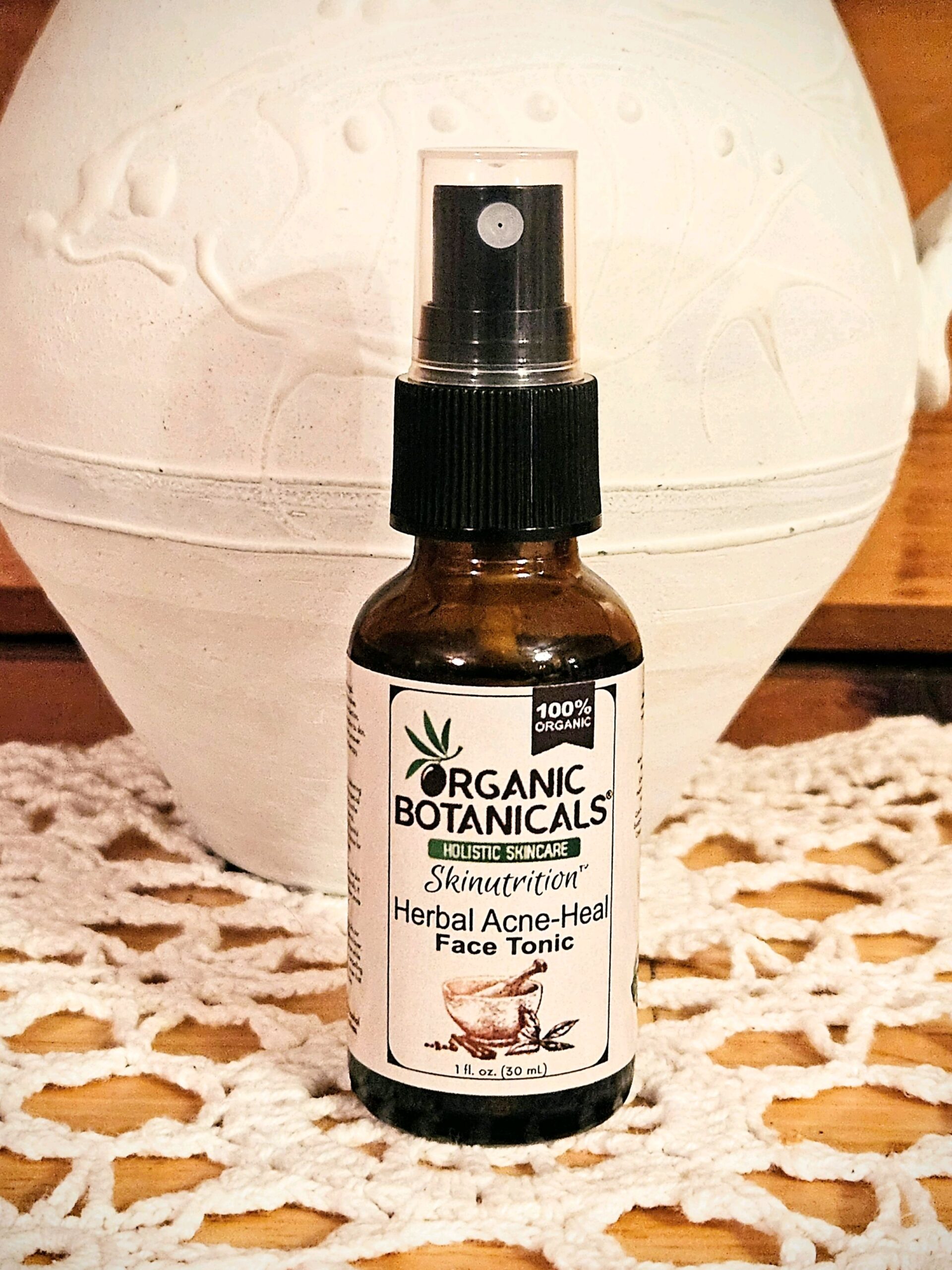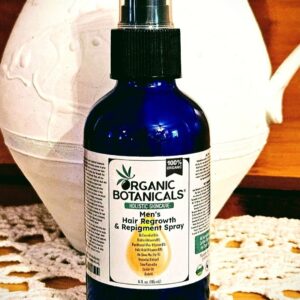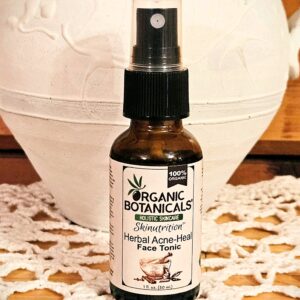Your cart is currently empty!
Organic Botanicals Herbal Acne-Heal Face Tonic – 1 Ounce
$19.49
Description
Helps heal acne by cleansing, clarifying, and delivering powerful herbal extracts to affected skin. It has anti-inflammatory properties that soothe irritation and redness. Naturally antibacterial, antimicrobial, and antifungal, it helps kill off harmful bacteria on the skin which makes it an ideal choice for those with acne or other skin conditions.
Rich in antioxidants, this body spray helps to protect the skin from damage caused by free radicals. Additionally, it stimulates collagen production, leading to firmer, more youthful-looking skin.
Highly nourishing, with glycerin and enriching oils, our spray doesn’t strip away the skin’s natural moisture layer, which ensures sebum production stays in balance while keeping your skin soft and hydrated. All with a compelling aroma of frankincense, palmarosa, and other spices that provide stress-relief, in turn healing the skin.
Benefits:
Antibacterial, antimicrobial, antifungal.
Decreases sebum production.
Reduces redness and inflammation.
Reduces pain and irritation.
Speeds up cell turnover.
Increases white blood cells.
Increases circulation to skin.
Tightens pores.
Prevents scarring.
Diminishes hyperpigmentation.
Aromatherapy.
Directions:
Shake before each use. Spray onto cotton ball or clean fingers and rub onto face 1-2 times daily. Discontinue if allergic reaction occurs. Avoid contact with eyes. Store in a cool, dark place. Best if used within 3-4 months.
Best Ingredients:
Aloe Barbadensis (Aloe Vera) Juice, Raw Apple Cider Vinegar, Witch Hazel, Palm-free Glycerin, Lavandula Angustifolia (Lavender), Melaleuca Alternifolia (Tea Tree), Cymbopogon Martinii (Palmarosa), Daucus Carota (Carrot Seed), Helichrysum Italicum (Helichrysum), Boswellia Sacra (Frankincense), Cymbopogon Citratus (Lemongrass), Salvia Sclarea (Clary Sage), Eucalyptus Myrtaceae (Eucalyptus), Syzygium Aromaticum (Clove), Cinnamomum Verum (Cinnamon), Origanum Vulgare (Oregano), Mentha × Piperita (Peppermint) Oil.
All ingredients from Certified Organic and Fair Trade sources.
Notes from Dr. Robert S. Mendelsohn:
“Acne is a skin ailment that afflicts many. This disfiguring disease is the plague of countless teenagers and some younger children and adults as well. The physical effects are quite well understood, but the medical profession remains baffled by the underlying causes. Little or no progress has been made in relieving the symptoms of acne, much less curing it, without what are, to me, unacceptable risks.
MOST ACNE TREATMENTS ONLY MILDLY HELPFUL.
More than 150 over-the-counter preparations are available for the treatment of acne. Most of the better-known ones contain benzoyl peroxide, which eliminates some of the oil and may offer mild relief to some patients. Even if it doesn’t, your teenage son or daughter is better off using one of these preparations than some of the more hazardous but no more effective treatments that doctors prescribe. During the years that I have practiced I have watched doctors treat acne victims with antibiotics such as tetracycline and erythromycin; vitamin A in massive (and harmful) doses; zinc sulfate tablets; cortisone; injections of triamcinolone acetonide to drain the lesions; hormone therapy; ultraviolet light; lotions containing sulfur, sodium thiosulfate, salicylic acid in various combinations with alcohol; dermabrasion; chemical face peels; x-ray treatments; and even, incredibly, gynecological surgery! And after all of that witch-doctoring, some of them still have the nerve to call nutritionists quacks!
I won’t get into the damage caused by all of these treatments, none of which really works, but let me illustrate what can happen to patients when doctors use unproven and untested treatments by discussing a few of them.
Twenty years ago tens of thousands of acne victims were given x-ray treatments in an effort to control or eliminate the disease. In fact, I prescribed these treatments myself. The results of this dangerous and irrational behavior are evident today in a virtual epidemic of thyroid tumors, some of them malignant, among those exposed to catastrophic radiation for this and other conditions.
Although they have abandoned x-ray therapy for acne, pediatricians and dermatologists have substituted other treatments, that are largely ineffective and present hazards of their own. Various tetracycline preparations are being used, despite the risks. Prolonged use of this antibiotic may render your body susceptible to serious infection because its effects are not limited to harmful bacteria. It kills the protective bacteria in the body as well, opening the way to serious infections that were rarely seen 30-40 years ago. Tetracycline may also permanently yellow teeth and even invade bones.
Acne victims whose complexions are profusely pitted and scarred are also being urged to improve their appearance by dermabrasion. This procedure involves the use of sandpaper, wire brushes, and other abrasive material to remove a layer of skin containing the acne scars. The effectiveness of this procedure has never been established. A study reported in 1977 by a researcher at Houston’s Baylor College of Medicine found that ‘Treatment of acne pitting and scarring by classic dermabrasion is, at best, somewhat disappointing; at worst it is unsuccessful and frequently accompanied by undesirable sequelae.’
WHAT ABOUT ACCUTANE?
The newest actor on the acne treatment scene is a derivative of vitamin A, Cis-retinoic acid, which has been available in the United States by prescription since September 1982. It is marketed by the Swiss pharmaceutical firm, Hoffmann-LaRoche, under the trade name Accutane. It was estimated that doctors wrote 60,000 prescriptions for the drug during the first two months in which it was available.
Accutane differs from other drugs used in the treatment of acne in one major respect. It works, but no one, including the manufacturer and the FDA, knows how or why. In clinical trials it was effective in about 90 percent of the cases. That’s the good news. The bad news is that it has such a frightening array of side effects that reputable dermatologists are extremely wary about using it. Too many others, however, are prescribing it with the same abandon that x-ray treatments were used 20 years ago, without fully apprising their patients of the potential consequences.
The risks and side effects are considerable. The FDA drug bulletin has pointed out that Accutane causes inflammation of the lips in more than 90 percent of the patients who use it. Up to 80 percent of the patients developed dryness of the skin or mucous membranes, 40 percent developed conjunctivitis, and almost 10 percent experienced a rash or thinning of the hair. Five percent experienced peeling of the palms of the hands and soles of the feet, skin infections, and increased susceptibility to sunburn.
My heart goes out to those who are afflicted with acne and to sensitive and caring parents who must suffer the emotional and psychological consequences along with them. I can also understand why the victim would gladly endure almost any risk to be able to look in the mirror and see a face that is blemish-free.
What you must consider, if it is your child who is affected, are the additional potential short- and long-term consequences of the drug. New ones emerge almost daily. If your teenager has acne, you must weigh the risks and benefits of Accutane and decide whether the benefits are worth the risks. In order to do that, however, you should be made aware of ALL the risks, not merely the obvious ones experienced by most of those who take the drug. It is doubtful that your child’s doctor will give you this information in all of its troubling detail, so I will provide it here. My purpose is not to make your decision for you but to enable you to make an informed judgment about the use of this drug and decide whether you and your child are prepared to trade a short-term miracle for a potential long-term disaster.
The prescribing information on Accutane reveals not only that it acts on the skin but that high concentrations of the chemical reach many tissues other than those at which the treatment is directed. Experimental studies show that after seven days the presence of the drug can be detected in the liver, ureter, adrenal gland, ovaries, and lachrymal (tear) glands. The drug also produces reactions in the blood. Twenty-five percent of patients experienced an elevation in plasma triglycerides, 15 percent developed a decrease in high-density lipoproteins (HDL), and 7 percent showed an increase in cholesterol levels. These three factors are of major importance in the development of vascular disease of the heart and blood vessels. This side effect is of such concern that the manufacturer of Accutane recommends that ‘Blood lipid (fats) determinations should be performed before Accutane is given and then at weekly or biweekly intervals until the lipid response to Accutane is established.’
Not only can Accutane affect the fatty elements in the bloodstream, but 40 percent of patients who received the drug showed evidence of other abnormal blood conditions which indicated that something was wrong without identifying precisely what the problem was. Thirteen percent developed high platelet counts, a change that can lead to disturbances in blood clotting. Ten to 20 percent showed decreases in red blood cell counts and white blood cell counts, the presence of white cells in the urine, and abnormal levels of blood enzymes (SGOT). Other users of Accutane (less than 10 percent) showed protein in the urine, red cells in the urine, or elevated blood sugars.
In clinical trials, five patients treated with Accutane for more than two years showed skeletal abnormalities. Three adults had spine degeneration, and two children displayed X-ray findings of premature closure of the epiphyses. The last finding is of particular importance to adolescents, because the epiphysis is that part of the bone that normally stays open until full growth is achieved. Premature closing of the epiphysis will prevent a child from attaining normal stature. Another indicator of bone growth, the blood alkaline phosphatase level, is abnormal in 14 percent of Accutane-treated patients.
In 72 human patients who had normal pretreatment eye examinations, five developed corneal opacities (cataracts) while on Accutane.
Of potential importance to adolescent boys are experimental results in dogs showing degeneration of the testes after Accutane treatment, and also depression of sperm production. Studies evaluating the effects of Accutane on sperm production in humans are now being conducted.
POTENTIAL RISKS TO FEMALES
There is also potentially grave significance to adolescent girls and women in the propensity of the drug to cause fetal deformities in the offspring of experimental animals that receive it. In rabbits, Accutane was toxic to the embryo and resulted in induced abortion. No adequate studies of Accutane have been done on pregnant women, but it is clear that the manufacturer is sensitive to the possibility that it could be another thalidomide. The prescribing information provided by the manufacturer cautions that ‘… patients who are pregnant or intend to become pregnant while undergoing treatment should not receive Accutane. Women of child-bearing potential should not be given Accutane unless an effective form of contraception is used, and they should be fully counseled on the potential risks to the fetus should they become pregnant while undergoing treatment. Should pregnancy occur during treatment, the physician and the patient should discuss the desirabilty of continuing the pregnancy.’ The manufacturer is concerned enough about fetal abnormalities to urge that ‘contraception be continued for one month or until a normal menstrual period has occurred following discontinuation of Accutane therapy.’
There is no question that Accutane relieves or eliminates the symptoms of acne in most of those who use it, but the mechanism that produces this benefit, and causes the abundance of side effects, is unexplained. Because it has been in use for a relatively short time, the long-term consequences, of course, are not known. Looking at the myriad threats that it poses, it is fair to note that its approval for human use is dubious, at best. If a chemical with as many dangerous properties as Accutane were sold as a treatment to remove wax from your kitchen floor, there would be a skull and crossbones on the label and a vivid warning, ‘Not to be taken internally.’ Yet doctors are apt to prescribe it with little or no warning at all.
This places an enormous responsibility on parents to guide their children in deciding whether to use the drug. A child with severe acne has an almost irresistible incentive to ignore the risks of Accutane. Furthermore, adolescents are more prone than adults to view disaster as something that happens only to others and choose the course of immediate self-gratification rather than that of common sense. Teenage automobile insurance rates, and adolescent use of street drugs, reflect those tendencies. Consequently, it is probable that a teenager with a badly marred face will discount the potential adverse consequences of using Accutane because of his compulsion to ‘get rid of the zits.’ He’ll view the side effects as something that will be experienced by others and convince himself that ‘it won’t happen to me.’ This makes it imperative that parents compel their child to consider thoroughly the risks of Accutane and participate with him in deciding whether the drug will be used.
My own behavior may be influenced somewhat by remorse over my ill-considered decision 30 years ago to prescribe X-ray treatment for acne, but I will not prescribe Accutane for my patients. The known risks are reason enough, and only the Lord knows the magnitude of the long-term damage that has yet to be disclosed.
EXPERIMENT WITH SAFE APPROACHES
The field of acne treatment is rich in theory and devoid of evidence of treatments that work, other than Accutane. Every doctor and health expert who treats acne has a catalog of treatments that he insists work for him. There is no scientific evidence that any of them do. Consequently, my strategy over the years has been to employ only the treatments that are least likely to damage the patient. Just like the more damaging ones, some of them work and some of them don’t, but I don’t know why, and neither does anyone else. Moreover, none of them requires medical supervision, so you can experiment until you find the most successful treatment without risks.
Nutritional approaches to the problem seem to work. Dr. Jonathan Wright, who writes an excellent column in Prevention magazine, offers one bit of evidence of a dietary relationship that, while not scientific, is convincing. He notes that acne was unknown among northern Canadian Eskimos until they shifted from a ‘primitive’ to a civilized diet. At that point the incidence of acne among these Eskimos reached almost 100 percent. Dr. Wright is only one of many reputable physicians who believe that at the present low level of medical knowledge a nutritional approach is the only sensible way to deal with the disease.
‘I have found only a few cases of acne (even bad ones),’ Dr. Wright says, ‘which were resistant to treatment involving cleaning up the diet, avoiding food allergens, and adding such things as zinc, essential fatty acids, B-complex vitamins, and vitamin A. Even in many of the resistant cases, attention to factors of nutrient assimilation seems to help. In fact, I have hardly treated anyone in the last four or five years whose acne didn’t settle down to a dull roar or to nothing at all with nutrition-related treatment.’
I advise my patients who are victims of acne to pay particular attention to nutrition, not only to identify through elimination diets the foods that may aggravate the condition but to find a diet that will improve it. Don’t bother talking to your doctor about nutrition, because he doesn’t know anything about it and consequently doesn’t believe in it. He believes in better living through chemistry and will probably prescribe tetracycline, hydrocortisone, or Accutane. Instead of seeing a doctor, read some good books on nutrition and try the procedures they recommend. Look for books by nutritionists Adele Davis, Carlton Fredericks, Michio Kushi, Paavo Airola, Dale Alexander, and Rudolph Ballentine.
Try diets that avoid refined sugar, white flour, and all processed foods containing chemical additives or preservatives of any kind. Carefully monitor your child’s diet to determine whether his acne outbreaks coincide with the ingestion of any particular foods. Observe cleanliness but avoid excessive scrubbing of the affected areas, which may cause more harm than good. If you feel compelled to use some form of topical medication, see your druggist, not your doctor. The preparations that are sold over the counter are safe compared to the medications a doctor or dermatologist may use.”
No additional shipping cost information provided.
Additional information
| Certification |
|---|
Only logged in customers who have purchased this product may leave a review.
Vendor Information
- Store Name: Organic Botanicals
- Vendor: Organic Botanicals
- 5.00 rating from 1 review











Reviews
There are no reviews yet.